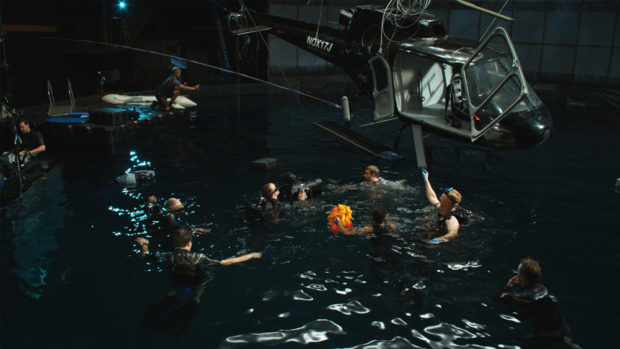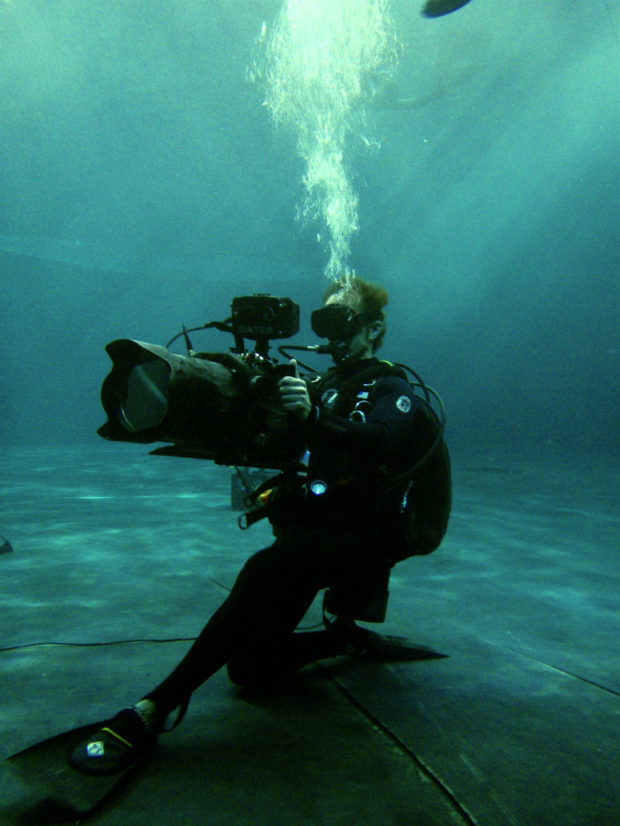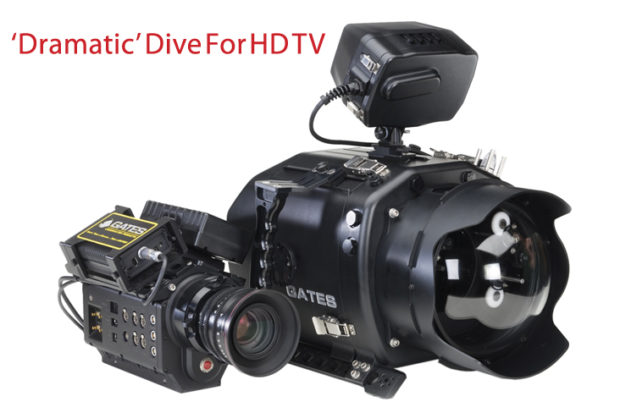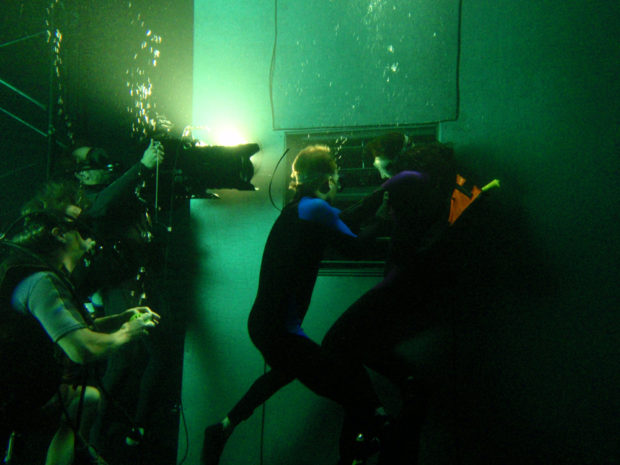High Definition TV looks better all the time. Recently, a Red One camera in a Gates housing was used at Vancouver Film Studios to shoot an episode of Sanctuary, the technology’s underwater debut in a dramatic television series production.
Text by Ian Seabrook – C.S.C.

Professional underwater cinematography is demanding. A multitude of skills are required and the ability to multitask central to the success of a shoot. There’s a great deal more to the job than taking a camera underwater and pointing it at a subject. Fundamentally, of course, your diving skills must be so ingrained that they are second nature; when the director says “action” your full attention is focused on ‘getting the shot.’
Understanding camera operation and being proficient, like so much in life, is learned. It’s important to know about the wide array of cinema formats, camera systems and certainly not least in this mix, is having an eye for composition. And then there is the job of staying abreast of technology.
Today, the trend in episodic television is to shoot High Definition (HD) format; it’s been gaining momentum since about 2005. In Vancouver, where film and television production have been a significant economic force for years, the creative team behind the Sci-Fi series Sanctuary opted to shoot with the Red One, the first digital cinema camera manufactured by Red Digital Cinema Camera Company (www.red.com). It’s among several cameras on the market that provide about four times the resolution of standard HD and when you combine that with their relatively low cost, it’s not hard to understand why they’ve been flooding the digital cinema market since their introduction some four years ago. At approximately one third the price of a professional high end HD camera – costing hundreds of thousands of dollars – this new technology is opening up the market for both professional and amateur filmmakers wanting to own their own digital cinema cameras, but with budgets more modest than those of large studios.
The technology is truly changing the cinematic landscape. These cameras are being used increasingly in both big screen and small screen productions. Film director Peter Jackson
(Lord of the Rings trilogy and King Kong), has embraced the technology although the films just mentioned were shot on motion picture film. Another adherent is Director Steven Soderburgh, whose recent release, Che, about Cuban revolutionary, was shot with the Red One digital cinema system.
The Red One system uses both flash cards and digital hard drives to record media and images and allows immediate playback of the recorded information at the same film speed – standard motion picture 24fps or slow motion – at which it was shot. No film camera and most professional HD camera systems offer this valuable feature. Simply put, this allows the filmmaker to know ‘on the spot’ whether or not he or she got the shot, saving time and money. Older technology involves waiting for a lab to develop film or for digital post delivery of HD media.

In Vancouver, Sanctuary co-creator and director Martin Wood envisioned an episode set entirely in and around water. At the time underwater housings for the Red One were in development but nothing was on the market. Enter Gates Underwater Products, a manufacturer of underwater housings for pro-sumer and high-end video cameras.
Beginning in late 2007, Gates’ President John Ellerbrock, in collaboration with accomplished underwater filmmaker Howard Hall, whose credits to date include three 3D IMAX films (DIVER June 2009), collaborated on the design of the ‘Deep Red’ housing. It soon became one of the largest projects the company had undertaken.
The Sanctuary episode taking viewers underwater was to be the Deep Red’s first foray into dramatic television and cinema production. To meet the fast approaching shooting schedule, Ellerbrock’s team gave top priority to completion of the customized Deep Red system that I’d requested and which would accommodate special cinema lenses with custom lens gearing and extenders for glass dome and flat ports.
Lenses designed for cinema shooting can differ from others. Quality is one consideration, the range of focal lengths another. In underwater 35mm cinematography, zoom lenses are rarely used due to their length and limitations imposed by housing size. Most underwater housings for cinema cameras use prime or fixed – e.g. 18mm, 25mm, etc. – focal length lenses. The RED system can accommodate cinema lenses used on film cameras, something other HD camera systems cannot do.
For Sanctuary I chose to use the French Angenieux Optimo 15-40mm short zoom lens, used in cinema shooting for its versatility and light weight. For me, working in the water, the decision to use this lens was more for speed and efficiency. Ten minutes is the average time it takes to change a prime lens on a film camera in an underwater housing.
Cameras such as the Red One produce heat when powered up and are recording. Like most professional HD cameras, the Red One is equipped with cooling fans but encasing it in a housing can cause heat build up and possible camera shut down, so the Gates housing design incorporates additional cooling fans. During the Sanctuary shoot, Ellerbrock was on hand to monitor this and other performance aspects of his housing, with a view to ongoing product improvement.

The Deep Red’s maiden dive was in a 12-foot (3.7m) deep tank erected at Vancouver Film Studios by Brent Meadows, a specialist when it comes to providing warm, crystal clear water for underwater shooting. The episode, titled Next Tuesday and scheduled to air approximately late November on the SPACE channel, was shot over five days on and under the water, which is almost unheard of, if not unique, to episodic television production nowadays due to the time-consuming shooting schedule and attendant cost.
The episode involves the show’s two main characters, Dr. Helen Magnus (played by Amanda Tapping) and Dr. Will Zimmerman (played by Robin Dunn), who are in a helicopter – also carrying an aggressive cephalopod, aka vampire squid – that crashes and comes to rest inside a bore well 75 feet (23m) below the surface. Stranded, the two survivors cope with the squid, which has escaped from the chopper and is lurking in the waters below.
There was lots of excitement shooting this episode, even if the special effects critter wasn’t actually showing up for work each day. Preparing the cast for underwater filming involved dive training, supervised by Jon Stephenson and ably assisted by safety divers Chris ‘Crash’ Bignell, Braden Haggerty and Greg…, These skilled divers tended to the safety needs of the cast, from air supply to buoyancy to whatever was needed through five days of shooting. In some cases, cast members possess varying degrees of diving skill, such as with principal Amanda Tapping. This can be advantageous especially if the shoot involves overhead environments and low light, not uncommon in underwater scripts, all of which can give rise to problems of claustrophobia and a general tension that can be counterproductive when the clock is ticking.

Underwater filmmaking is especially a collaborative effort. Other members of the dive team included underwater key grip Herb DeWaal, who built scaffolding decks and platforms to shoot from and who provided camera support by flagging off light flares to the housing’s lens port. Gaffer Patty Moore managed the underwater cinema lights used to illuminate the cast. The dive team on this Sanctuary shoot made a significant contribution to the final product that is scheduled to air soon on the SPACE channel. Keep an eye on your local TV listings.







